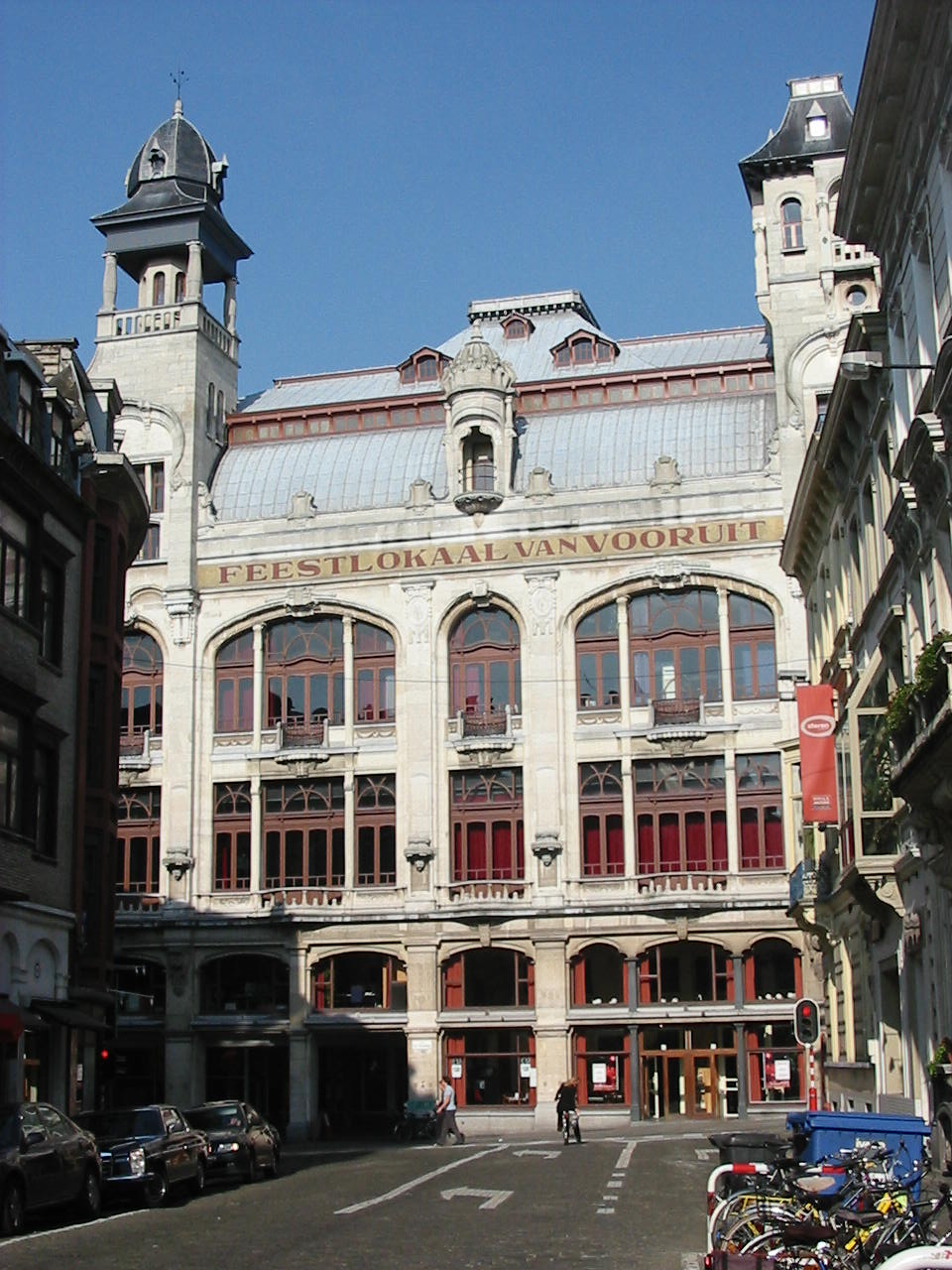Vooruit on:
[Wikipedia]
[Google]
[Amazon]
 Vooruit ( , ) is a historic complex in
Vooruit ( , ) is a historic complex in
Official website
{{Coord, 51, 02, 52, N, 3, 43, 40, E, type:landmark_region:BE, display=title Concert halls in Belgium Buildings and structures in Ghent Event venues established in 1914 Culture of Ghent Tourist attractions in East Flanders Socialism in Belgium Art Nouveau architecture in Belgium Art Nouveau theatres Tourist attractions in Ghent
Ghent
Ghent ( ; ; historically known as ''Gaunt'' in English) is a City status in Belgium, city and a Municipalities of Belgium, municipality in the Flemish Region of Belgium. It is the capital and largest city of the Provinces of Belgium, province ...
, Belgium. Vooruit was originally the festival and art centre of the Ghent-based labour movement, with a ballroom, cinema, theatre, etc. It is now mainly used for concerts and other cultural events.
History
Vooruit was designed by Ferdinand Dierkens and built between 1911 and 1914, becoming a symbol of thesocialist
Socialism is an economic ideology, economic and political philosophy encompassing diverse Economic system, economic and social systems characterised by social ownership of the means of production, as opposed to private ownership. It describes ...
movement in the interwar period. The building is named after the socialist consumer organisation
Consumer organizations are advocacy groups that seek to protect people from corporate abuse like unsafe products, predatory lending, false advertising, astroturfing and pollution.
Consumer Organizations may operate via protests, litigation, camp ...
(or cooperative
A cooperative (also known as co-operative, coöperative, co-op, or coop) is "an autonomy, autonomous association of persons united voluntarily to meet their common economic, social and cultural needs and aspirations through a jointly owned a ...
) ''Vooruit'' ("Forward") (1891–1970), supported by Edward Anseele
Edward Anseele (26 July 1856 – 18 February 1938) was a Belgian socialist politician. Edward Anseele became active in the early Belgian socialist movement. Anseele attended the Royal Athenaeum in Ghent until the age of 17.
Career
Edward Anseele ...
, to protect workers against the instability of capitalism
Capitalism is an economic system based on the private ownership of the means of production and their use for the purpose of obtaining profit. This socioeconomic system has developed historically through several stages and is defined by ...
. There workers could eat, drink and enjoy culture at affordable costs.
As a festival and arts centre
An art centre or arts center is distinct from an art gallery or art museum. An arts centre is a functional community centre with a specific remit to encourage arts practice and to provide facilities such as theatre space, gallery space, venues fo ...
, Vooruit was part of the compartmentalised Flemish society until World War II
World War II or the Second World War (1 September 1939 – 2 September 1945) was a World war, global conflict between two coalitions: the Allies of World War II, Allies and the Axis powers. World War II by country, Nearly all of the wo ...
. After the war, the building deteriorated until the re-launch in 1982 in its present form as a cultural centre. In 1983, Vooruit was recognised as a listed monument. The building continued operating during the restoration process, from 1990 to 2000. In 2000, a fully restored Vooruit was awarded the Flemish Monument of the year prize.
Presently the rooms are used for parties and concerts, but also for cultural events or debates.
See also
* The Maison du Peuple/Volkshuis, a similar building in Brussels built byVictor Horta
Victor Pierre Horta (; Victor, Baron Horta after 1932; 6 January 1861 – 8 September 1947) was a Belgian architect and designer, and one of the founders of the Art Nouveau movement. He was a fervent admirer of the French architectural theoris ...
for the Belgian Workers' Party
The Belgian Labour Party (, , BWP; , , POB) was the first major socialist party in Belgium. Founded in 1885, the party achieved its first electoral breakthrough in the aftermath of World War I. It was officially disbanded after the German invasi ...
and demolished in 1965
* Culture of Belgium
The culture of Belgium involves both the aspects shared by all Belgians regardless of the language they speak and the differences between the main cultural communities: the Dutch-speaking Belgians (mostly Flemish) and the French-speaking B ...
* Belgium in the long nineteenth century
In the history of Belgium, the period from 1789 to 1914, dubbed the "Long nineteenth century, long 19th century" by the historian Eric Hobsbawm, includes the end of Habsburg monarchy, Austrian rule and periods of French First Republic, French ...
References
External links
*Official website
{{Coord, 51, 02, 52, N, 3, 43, 40, E, type:landmark_region:BE, display=title Concert halls in Belgium Buildings and structures in Ghent Event venues established in 1914 Culture of Ghent Tourist attractions in East Flanders Socialism in Belgium Art Nouveau architecture in Belgium Art Nouveau theatres Tourist attractions in Ghent